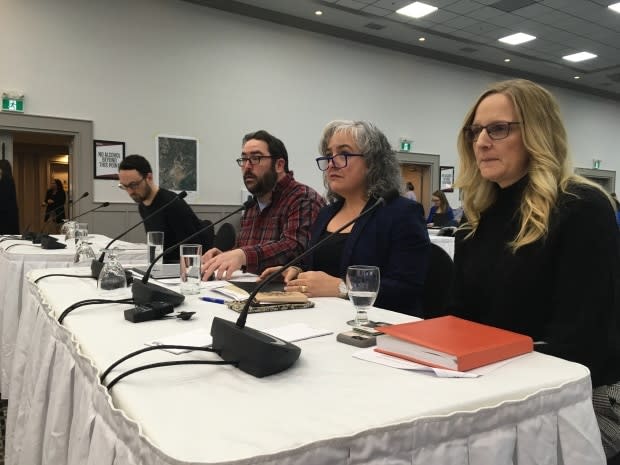Giant Mine remediation plan lacks vision, details, says City of Yellowknife
It's not quite clear what the former Giant Mine site will look like 10 years from now, or who will be in charge of how the land is used.
The issue has come up repeatedly during public hearings in Yellowknife this week. The Mackenzie Valley Land and Water Board is considering the Giant Mine Remediation Team's application for a water licence and land-use permit to begin its 10-year, $1 billion cleanup just a few kilometres from the city's downtown.
The City of Yellowknife recently drafted a 20-year community plan. It describes the entire Giant Mine area as "undevelopable."
In a presentation to the board Tuesday, city administrator Sheila Bassi-Kellett made a plea to the project to lay out options for what the Giant Mine site could be used for down the road.
"This land must provide potential value to our citizens," Bassi-Kellett said. "What that value will be, whether it's recreational or industrial, whatever it may be, this has got to be a collective decision from all our residents."
Questions have been raised over who exactly is in charge of future land-use planning for the site. On Monday, the remediation team talked about "constraints" on land use planning, while saying land-use planning lay outside of its authority.
The city can't drive this forward on its own. - Todd Slack, City's special advisor on Giant Mine
A representative for the territorial government, the land's owner, pointed out that the territorial government doesn't do land-use planning within municipal boundaries.
In 2010, the remediation team proposed cleaning the entire site to an industrial standard for arsenic contamination. The team later promised to restore parts of the site to a residential standard for arsenic.

That opens the possibility for a variety of land uses, but the city wants the remediation team to help "re-establish a concept of what that land use might be," said Todd Slack, the city's special advisor on Giant Mine.
Slack quoted Jeffrey Humble, a city planner who, at an environmental assessment hearing in 2012, said, "I've been a land-use planner for more than 10 years and I've never seen a land-use plan come at the tail end of a process."
"The city can't drive this forward on its own. The range of possible land uses now is unclear," he said.
'No consistent approach'
After reading a short poem (actually song lyrics, written specifically for the land and water board), Alternatives North also raised concerns over the lack of detail included in the closure and reclamation plan, including how the site will look.
"The [closure and reclamation plan] thus far does not appear to apply a consistent approach to design of the site's final appearance," said Michael Nabert.
"If the visual appearance of various aspects of the site do not communicate a consistent message to future generations, our capacity to clearly communicate what they need to know will be diminished," said Nabert.
The board will also hear from two federal government departments, the Giant Mine Oversight Board, the Yellowknives Dene First Nation, the North Slave Métis Alliance and the Yellowknife Historical Society before deciding whether, and on what terms, to issue the remediation team its licence and permit.

